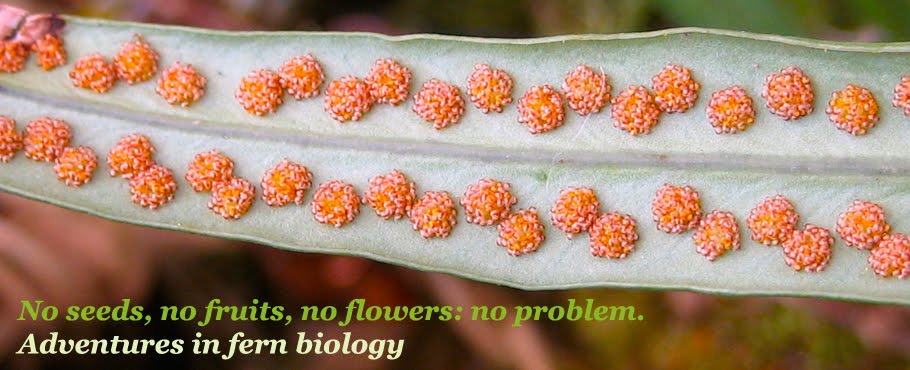I hope you'll forgive me a diversion into flowering plants... the spring flora of Wisconsin is particularly beautiful and full of lovely flowering things. Even I can appreciate them, and some of them photograph uncommonly well. There will probably be a few posts after this one that feature angiosperms, as I visit a few rich sites with public field trips and the class I'm TAing. Then it will be back to ferns! These flowers are all from the bluff in Grant County I've written about in the last few posts. The plant above is Sanguineria canadensis, the Bloodroot. Next is Wild Ginger, Asarum canadense:
Monday, May 16, 2011
A floral departure...
Wednesday, May 11, 2011
More fiddleheads!

The following two photos are Dryopteris marginalis, the Marginal Woodfern. It is easy to tell this one when it's still small and unfurled because of the distinctive scales, which are a golden brown color. Most Dryopteris have scales that look something like this, and you could potentially confuse this one with other members of the genus, but probably not with anything outside Dryopteris. One helpful thing with Dryopteris is to look for persistent green fronds from last year... D. marginalis can sometimes have them, which would also help get this to species.
Ostrich fern, Matteuccia struthiopteris, is a good fern to be able to identify in fiddlehead stage, since it's the only fern whose fiddleheads are considered safe to eat. This one is easy to identify because of the deep groove which runs down the front of the stipe (you can see it here), and also because of the very smooth look of the stipe, which you can see in the photo below. They can sometimes have a fairly dense covering of golden scales, but they seem to outgrow them quickly, unlike the Dryopteris, above, which hangs onto the scales for a long time as it grows.
Maidenhair fern, Adiantum pedatum, often has reddish to purple stipes, which make it easy to identify, as do the white hairs that frequently occur along the base of the stipe. The ones pictured here also have some scales in addition to the hairs, but the reddish coloration is the real giveaway that this is Maidenhair:
Saturday, May 7, 2011
Lady fern fiddleheads

More fiddleheads from the bluff in Grant County, WI. The last post focused on the ubiquitous Interrupted fern, while today's highlights another fern that was abundant at this site: Lady fern (Athyrium filix-femina). Athyrium can be very diverse, even among plants in a single location, as these photos demonstrate. Some of these plants had green stipes, while others were brown to purplish, and they had a variety of different scales and hairs. This species is easy to identify at this stage because of this variation, rather than in spite of it.
Sunday, May 1, 2011
Spring's first fiddleheads!
The most dominant fern at this site was clearly the Interrupted fern, Osmunda claytoniana. This species is easy to tell even this early because of the white fuzz of hairs that covers the fiddleheads and is also present in other close relatives, like the Cinnamon fern. With O. claytoniana, though, you can actually see the fertile pinnae that will make up the "interrupted" part of the frond even when the fiddleheads are quite small. This species was all over the north-facing side of the bluff, and according to Susan and Steve it becomes almost forest-like itself by summer! In the first photo below you might be able to make out some of the clumps of Interrupted fern covering the rocks... and once you've found a couple you'll probably notice more and more...
Subscribe to:
Posts (Atom)




























